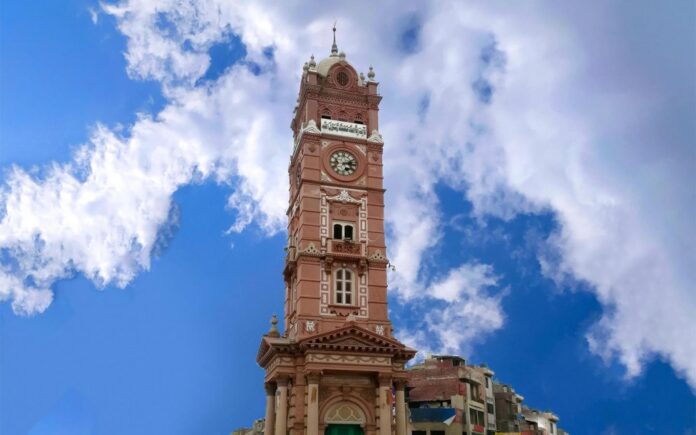Faisalabad, which used to be called Lyallpur, is one of Pakistan’s largest cities. It is a well-known city for its textile industries, high-quality cotton products, sports industries, traditional food, and rich cultural history.
Lyallpur became the third carefully planned city under British rule.Faisalabad’s Ghanta Ghar, which is the Urdu name for the clock tower, is almost always important to everyone.
Towing to the fact that it is the hub of city life. A well-known saying says that if you walk away from the Clock Tower, you’ll end up back at the Clock Tower.
In this blog, we’ll talk about how the Ghanta Ghar acts as a hub for the city of Faisalabad, bringing its various parts together.
Ghanta Ghar Faisalabad Location

In 1904, the districts of Samundri and Toba Tek Singh were joined to make the district of Lyallpur. A year earlier, in 1903, the Abdullahpur Mian family and Sir Charles Rivaz, the British Lieutenant Governor of Punjab, laid the foundation for Ghanta Ghar.
At, the bottom of the clock tower is a plaque that says the loyal people of Chenab Colony made the building to honor Queen Victoria.
The center of the old city of Faisalabad is Ghanta Ghar. It has classic British and Mughal architecture, and it shows how old and new things can live together in peace.
As the layout of the old city was based on the Union Jack, the tower was in the middle of a square surrounded by four main roads: Circular Road, Kotwali Road, Regal Road, and Sargodha Road. The major ways out of the Clock Tower and the surrounding bazaars are these four roads.
The plan for the city was based on the Union Jack, which is the flag of the United Kingdom. Around the clock tower are about eight markets or bazaars. They named each one after the direction it goes in.
This Clock Tower is hence the hub of all commerce in Faisalabad, and it continues to be so today. Many historical events in the city are related to the Clock Tower.
Historical Significance

Most people think that Ghanta Ghar is the only clock tower in the city. However, most people do not know the British had built that Faisalabad’s first clock tower in the Irrigation’s vicinity Department office.
It served various purposes; first, the clock installed on the tower used to ring every hour to update the people of the area about the time; second, the tower had an arrow at its top to direct passersby towards the city.
The British also used the bell to gather the people of the area, either to collect taxes from them or to communicate any important message. On top of the tower, a rain meter was also subsequently installed to measure the amount of rainfall.
After the first clock tower, railway and power lines were also laid out. Gumti and Qaisari Darwaza were the first two monuments that were built by the locals mainly to honour Queen Victoria on her birthday, to which the Muslims protested as they felt isolated for not having a monument that represented them in honoring Queen Victoria.
The British administration then along with Muslims and other religious minorities, built a second Clock Tower (present day Ghanta Ghar) that carries four different inscriptions on the bottom representing the Muslim, Sikh, Hindu, and Christian communities.
Because of this equal representation, and its unique design, the Ghanta Ghar has emerged as the center of the city and its various activities. For instance, during the election season, each of the political parties tries to hold a rally at this spot. The same is the case with protest demonstrations.
They also held here the rallies and processions of varying religious groups. In addition, the mayor of Faisalabad delivers his speech and uses the platform to inform the residents about anything important.
Famous Places Near Ghanta Ghar

There are several historical places in Faisalabad that you can visit whenever you visit the city. These places are:
Lyallpur Museum Faisalabad
They completed this museum in 2013 and carries within its walls the history and culture of the city. There are about 10 galleries inside the museum:
- Orientation Gallery
- Regional Heritage Archaeological Gallery
- Chenab Colony Gallery
- Sandal Bar Gallery
- Thought and Act Gallery
- Pakistan Movement Gallery
- Social Beauty Gallery
- Muslim to Sikh Period Gallery
- Textile Gallery
- Lyallpur Gallery
Jinnah Gardens
Sir Charles James Lyall was buried here, but Quaid-e-Azam Muhammad Ali Jinnah, the nation’s founder, is honored with the name of the cemetery.
Iqbal Stadium
Iqbal Stadium, one of Pakistan’s premier cricket venues, has a capacity of 18,000 and has played host to 25 test matches and 14 One-Day Internationals (ODIs). Lyallpur Stadium, National Stadium, and City Stadium were their previous names. Currently, it holds Allama Iqbal, the national poet of Pakistan.
Final Words
The Ghanta Ghar in Faisalabad has been the focus of many comparisons and is a hotly debated subject. Because of the manner in which they were constructed, some people have compared the Ghanta Ghar and its eight bazaars to a military force or a dictator, which implies that the tower continues to be the focal point of all activities.
They contend military leaders merge authority and maintain their position as the centre, much like the Ghanta Ghar.
It was all about Ghanta Ghar Faisalabad. Hope You have enjoyed this article!
Thanks for reading…..


